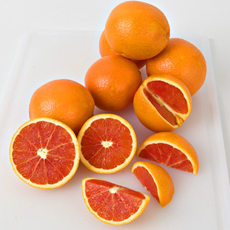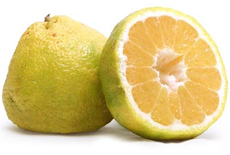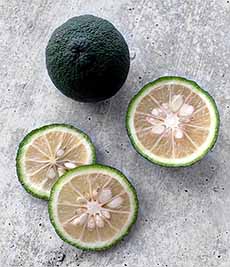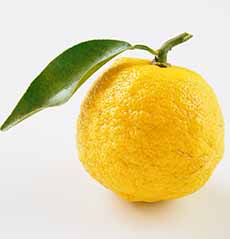TIP OF THE DAY: Winter’s Seasonal Fruit, Citrus
|
While many delightful fruits have gone “on hiatus” until next summer, winter is not without its comforts: citrus fruits. Get your fill of the winter citrus bounty, and especially seek out varieties you haven’t had before.
All of the following are different species in the Citrus genus: order Sapindales, family Rutaceae. A good blood orange is our favorite citrus. Named for their deep pink or red-streaked flesh, blood oranges are smaller than other oranges and have slightly rougher skin. The skin often has a red blush. Once a rare European import, blood oranges from California are now in abundant supply in the U.S. from December through March. If you keep trying them, you may find the simply celestial ones with luscious, raspberry-orange-flavored flesh*. They are a variety of conventional orange, Citrus × sinensis. Here’s more about blood oranges. Another citrus delight (when you get a good one), Cara Cara oranges are worth seeking out. A variety of navel orange, it has rosy pink, juicy, sweet flesh and low acidity. The taste is sweet with undertones of cherry. The variety was discovered in 1976 as a mutation at the Hacienda de Cara Cara in Valencia, Venezuela. They are also a variety of conventional orange, Citrus × sinensis. Here’s more about Cara Cara Oranges. Grapefruits, Citrus × paradisi, have been a seasonal staple in the East since the 1920s, when winter visitors to sunny Florida drove back with carloads of them for friends and family, along with oranges and jars of orange and grapefruit marmalade. Eventually, growers began shipping commercially to the north and then nationwide. While is was most commonly served at breakfast, halved and usually topped with honey or sugar, it is now used in many recipes, including our favorite, grapefruit sorbet. Pommelos/pummelos are a different fruit, Citrus maxima, also known Citrus grandis. They have a much thicker peel. a green-tinged skin and a slightly drier texture. They can be substituted for grapefruit in any recipe. KUMQUATS These wee fruits, looking like teeny oval oranges, are C. japonica, although the name comes from the Chinese gam gwat, meaning golden tangerine. (C. is the abbreviation for Citrus; in taxonomy, to shorten the genus and species, the genus is usually designated by the first letter of its name.) You eat them skin and all (except for the seeds), but some varieties can be tart. Halve them and toss them into green salads and fruit salads, chicken and shrimp salads. First note that it’s “mandarin,” not a “mandarin orange” or “satsuma orange”; the two are separate genuses (more about that below). There are many varieties of mandarins, Citrus reticulata, bred the world over. In the U.S. it’s easy to find clementines, satsumas, tangerines and tangelos. They are relatively similar size and appearance (as well as calories—50—and nutrition), and the lay person can confuse them. Yuzu is a unique hybrid of Ichang papeda (a primitive citrus) and a sour mandarin. It originated in China and is widely cultivated in Japan. The fresh fruit cannot be imported into the U.S., but bottled juice is available. California farmers have begun to grow yuzu, so it may arrive in your grocery store at some point. Or, head to Melissa’s Product. The golf ball-size yuzu has an intoxicating fragrance and zesty flavor juice. The lemon-lime flavor is fruity but less sharp and more subtle than lemon. Like lemons, the fruit is green when it first begins to grow (photo #7). As it ripens it becomes yellow, like a lemon (photo #8). There are three basic citrus types—citron, mandarin and pomelo/pummelo—from which all other modern citrus varieties derive via hybrids or backcrosses. While they look like small oranges and are often called “mandarin oranges,” mandarins are a separate species that includes the clementine, mineola (red tangelo), murcott (also called honey tangerine), tangelo, temple and satsuma, among others. |
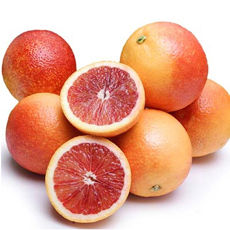 [1] These three photos show flesh of similar colors, but the flavors are very different. Here, Blood Oranges from Melissa’s.
|
|
|
More Confusion
Mandarins are also called loose-skin oranges—a usage which is both unfortunate and confusing given the numerous, highly distinctive differences between the two genuses. According to the experts at U.C. Davis: The mandarin reached the Mediterranean basin in the early 1800s, and arrived in Florida about 1825. Thanks to the University of California Davis for providing this information. You can read more here. Then, go out and gather some great citrus fruits. CHECK OUT WHAT’S HAPPENING ON OUR HOME PAGE, THENIBBLE.COM. |
||
